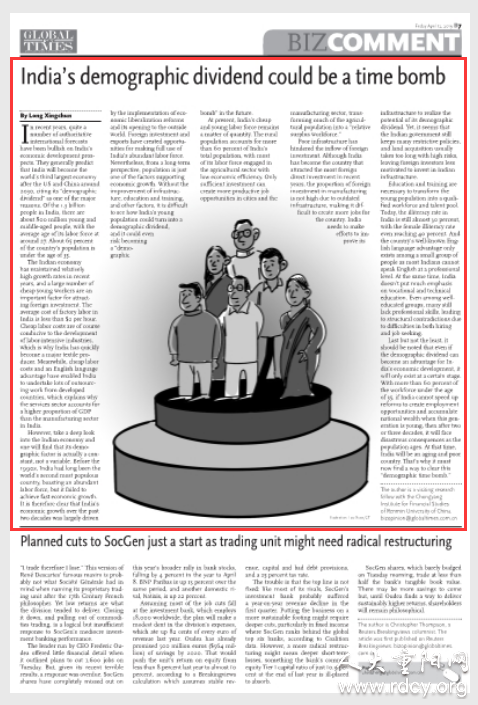Major Power Relations
Your Present Location: PROGRAMS> Major Power RelationsLong Xingchun: India's demographic dividend may risk turning into a time bomb
By Long Xingchun Source: Global Times Published: 2019-4-11

In recent years, quite a number of authoritative international forecasts have been bullish on India's economic development prospects. They generally predict that India will become the world's third largest economy after the US and China around 2030, citing its "demographic dividend" as one of the major reasons. Of the 1.3 billion people in India, there are about 800 million young and middle-aged people, with the average age of its labor force at around 27. About 65 percent of the country's population is under the age of 35.
The Indian economy has maintained relatively high growth rates in recent years, and a large number of cheap young workers are an important factor for attracting foreign investment. The average cost of factory labor in India is less than $2 per hour. Cheap labor costs are of course conducive to the development of labor-intensive industries, which is why India has quickly become a major textile producer. Meanwhile, cheap labor costs and an English language advantage have enabled India to undertake lots of outsourcing work from developed countries, which explains why the services sector accounts for a higher proportion of GDP than the manufacturing sector in India.
However, take a deep look into the Indian economy and one will find that its demographic factor is actually a constant, not a variable. Before the 1990s, India had long been the world's second most populous country, boasting an abundant labor force, but it failed to achieve fast economic growth. It is therefore clear that India's economic growth over the past two decades was largely driven by the implementation of economic liberalization reforms and its opening to the outside world. Foreign investment and exports have created opportunities for making full use of India's abundant labor force. Nevertheless, from a long-term perspective, population is just one of the factors supporting economic growth. Without the improvement of infrastructure, education and training, and other factors, it is difficult to see how India's young population could turn into a demographic dividend, and it could even risk becoming a "demographic bomb" in the future.
At present, India's cheap and young labor force remains a matter of quantity. The rural population accounts for more than 60 percent of India's total population, with most of its labor force engaged in the agricultural sector with low economic efficiency. Only sufficient investment can create more productive job opportunities in cities and the manufacturing sector, transforming much of the agricultural population into a "relative surplus workforce."
Poor infrastructure has hindered the inflow of foreign investment. Although India has become the country that attracted the most foreign direct investment in recent years, the proportion of foreign investment in manufacturing is not high due to outdated infrastructure, making it difficult to create more jobs for the country. India needs to make efforts to improve its infrastructure to realize the potential of its demographic dividend. Yet, it seems that the Indian government still keeps many restrictive policies, and land acquisition usually takes too long with high risks, leaving foreign investors less motivated to invest in Indian infrastructure.
Education and training are necessary to transform the young population into a qualified workforce and talent pool. Today, the illiteracy rate in India is still almost 30 percent, with the female illiteracy rate even reaching 40 percent. And the country's well-known English language advantage only exists among a small group of people as most Indians cannot speak English at a professional level. At the same time, India doesn't put much emphasis on vocational and technical education. Even among well-educated groups, many still lack professional skills, leading to structural contradictions due to difficulties in both hiring and job seeking.
Last but not the least, it should be noted that even if the demographic dividend can become an advantage for India's economic development, it will only exist at a certain stage. With more than 60 percent of the workforce under the age of 35, if India cannot speed up reforms to create employment opportunities and accumulate national wealth when this generation is young, then after two or three decades, it will face disastrous consequences as the population ages. At that time, India will be an aging and poor country. That's why it must now find a way to clear this "demographic time bomb."
The author is a visiting research fellow with the Chongyang Institute for Financial Studies of Renmin University of China.























































































 京公网安备 11010802037854号
京公网安备 11010802037854号





